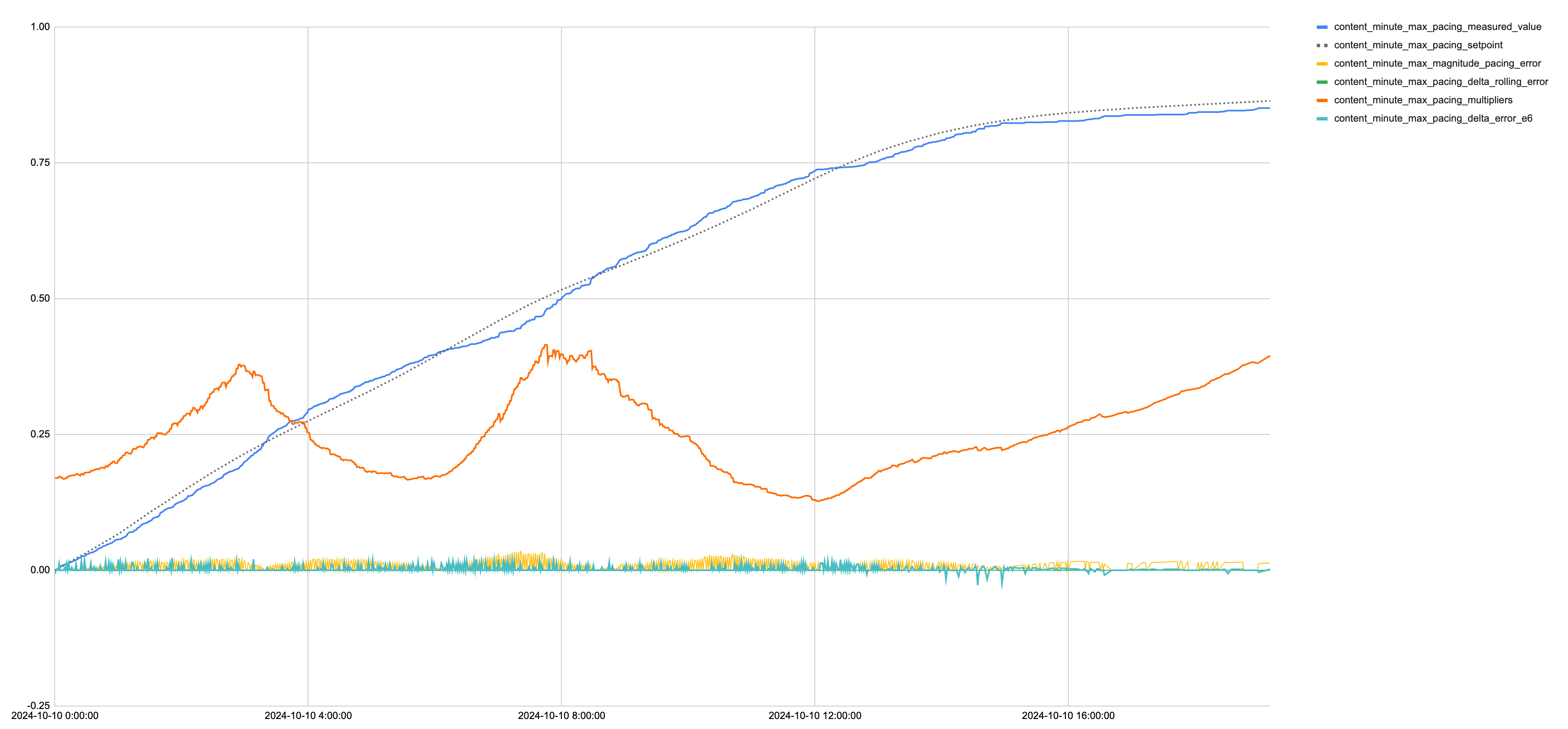Pacing and Daily Budgets
How Promoted adjusts bids over time to efficiently manage the limited budgets of advertisers. Extensions can be applied to manage expected resource use over any period of time, like impression limits.
Pacing is a strategy known in ad tech for evenly spending a budget over a period of time, typically a day, to improve ad delivery efficiency. This can be efficient because the pacer avoids overspending early in the period by lowering the bid to save the budget to win later in the period. Theoretically, bid pacing is an auction theory strategy for estimating the value of not winning an auction to conserve limited resources to participate in expected future auctions. Pacing is a type of "auto bidding."
Promoted implements bidding strategies similar to Meta's strategy. Promoted's infrastructure is highly modular, and our pacing system can be customized for different objectives, periods, and future opportunity models.
Daily Budget
A daily budget is the dollar amount the advertiser wants to spend on ads each day. This amount is usually represented as an average per day, so the platform can reserve some budget from low-traffic days to spend on high-traffic days. Daily budgets are managed by pacers, described below, which adjust bids to ensure the budget is spread out over time.
Pacing
A pacer is an Auto-Bidder that adjusts insertion bids of an ad over time to account for opportunity costs given a limited budget for delivery from the advertiser. This budgeting is typically implemented as a target “opportunity curve” of expected cumulative allocation opportunities per day. A pacer tries to spend the daily budget slowly and optimally to track this opportunity curve. Promoted uses two types of pacers:
- Probabilistic pacer. The auto-bidder drops out of auctions at a certain probability.
- Discount pacer. The bid multiplier is continuously adjusted, usually using a PID controller. The bid is changed on a per-auction basis using a real-time feedback loop, comparing ad spending to projected ad opportunities.
Opportunity curve
Ads pacing compares the actual cumulative delivery (as a percentage of the target) to an expected cumulative delivery (as a percentage of the target) within a fixed period, such as 24 hours. The opportunity curve is the expected cumulative spend in time.

A real, normalized pacing curve from a Promoted customer for a portion of a day. The actual spend (blue) closely tracks the expected spend (dotted). The bid multiplier (orange) reacts dynamically to actual spend.
A simple solution is to spend the budget equally throughout the day. In other words, the expected spend is 0% at 00:00 UTC, 50% at 12:00 UTC, and 100% at 24:00 UTC, then resetting back to 0%. In practice, the curve should optimally track expected clicks and impressions in the appropriate time zone to proportionally distribute the budget. This ensures the budget isn't being overspent at times when user engagement is low.
Strategies
In implementing Promoted's pacing strategies, Promoted combines two competing concepts: positive and negative pacing.
- Negative pacing. This technique restricts delivery to limit costs to the seller. Sellers may only have a limited budget, which means there is value in losing an ads auction.
- Positive pacing. This technique boosts delivery to limit costs to the marketplace. It is an efficient way to explore new items or guarantee a minimum seller experience.
Positive and negative pacing can be combined to enforce upper or lower bounds in delivery.
Negative Pacing
Ideally, advertisers want only profitable ad opportunities (i.e., leading to impressions or conversions) to be delivered. If a seller has a limited budget, then they want to prioritize the most profitable opportunities. However, opportunities happen in time, and the system doesn't know when the profitable opportunities will occur. If the budget is spent too early, better opportunities in the future may be missed.
A negative pacer estimates the value of losing a given auction. This value depends on how many expected better opportunities remain in the day and how much budget the advertiser will have (by either winning or losing) to try to win those opportunities.
Unlimited budgets may still need negative pacingIn theory, if an advertiser has an unlimited budget and can win every auction, then the value of losing is usually zero. However, if there are other delivery constraints, like repetition limits, there may be value in losing an auction even with an unlimited budget.
Positive Pacing
Ads and promotions are not necessarily without consequence to the marketplace — each ad delivered may contribute to a worse experience for the user. However, ads may contribute in positive ways:
- Achieving a minimum value delivered for every seller
- Increasing exploration and diversity
- Serving as a "cold start" to promote new sellers
In these cases, it is important to boost delivery while minimizing loss. If minimum delivery is already achieved or is projected to be achieved, then no boosting is necessary.
Updated 6 months ago